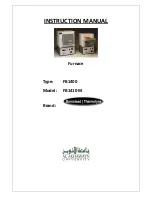
Manual
2100-535
Page
19 of 71
12. VENT RESIZING INSTRUCTIONS
When an existing furnace is removed from a venting
system servicing other appliances, the venting system is
likely to be too large to properly vent the remaining
attached appliances.
The following steps shall be followed with each of the
appliances remaining connected to the common venting
system, placed in operation one at a time while the
other appliances remaining connected to the common
venting system are not in operation.
1. Seal any unused openings in the venting system.
2. Inspect the venting system for proper size and
horizontal pitch, as required in the National Fuel Gas
code, ANSI Z223.1 or the CAN/CGA B149
Installation Codes and these instructions. Determine
that there is no blockage or restriction, leakage,
corrosion and other deficiencies which could cause
an unsafe condition.
3. In so far as is practical, close all building doors and
windows and all doors between the space in which
the appliance(s) connected to the venting system are
located and other spaces of the building. Turn on
clothes dryers and any appliances not connected to
the venting system. Turn on any exhaust fans, such
as range hoods and bathroom exhausts, so they will
operate at maximum speed. Do not operate a
summer exhaust fan. Close fireplace dampers.
4. Follow the lighting instructions. Place the appliance
being inspected in operation. Adjust thermostat so
appliance shall operate continuously.
5. Test for draft hood equipped appliance spillage at the
draft hood relief opening after 5 minutes of main
burner operation. Use the flame of a match or
candle.
6. After it has been determined that each appliance
connected to the venting system properly vents when
tested as outlined above, return doors, windows,
exhaust fans, fireplace dampers and any other gas-
burning appliances to their previous conditions of
use.
7. If improper venting is observed during any of the
above tests, the venting system must be corrected.
13. FRESH AIR INTAKE
All units are built with fresh air inlet slots punched in
the service panel.
If the unit is equipped with a fresh air damper
assembly, the assembly is shipped already attached to
the unit. The damper blade is locked in the closed
position. To allow the damper to operate, the
maximum and minimum blade position stops must be
installed. See Figure 9.
All capacity, efficiency and cost of operation
information as required for Department of Energy
“Energyguide” Fact Sheets is based upon the fresh air
blank-off plate in place and is recommended for
maximum energy efficiency.
The blank-off plate is available upon request from the
factory and is installed in place of the fresh air damper
shipped with each unit.
One of several other ventilation options may be
installed. Refer to model number and/or supplemental
installation instructions.
14. CONDENSATE DRAIN
A plastic drain hose extends from the drain pan at the
top of the unit down to the unit base. There are
openings in the unit base for the drain hose to pass
through. In the event the drain hose is connected to a
drain system of some type, it must be an open or vented
type system to assure proper drainage.
FIGURE 9
FRESH AIR DAMPER
Summary of Contents for W24G1DA
Page 13: ...Manual 2100 535 Page 13 of 71 FIGURE 2A MOUNTING INSTRUCTIONS FOR W42G W48G AND W60G...
Page 16: ...Manual 2100 535 Page 16 of 71 FIGURE 6 COMMON WALL MOUNTING INSTALLATIONS...
Page 26: ...Manual 2100 535 Page 26 of 71 FIGURE 12 GAS PIPE CONNECTION W24G W36G W42G W60G...
Page 57: ...Manual 2100 535 Page 57 of 71 W24G1DA W48G1DA W60G1DA 230 208 60 1...
Page 59: ...Manual 2100 535 Page 59 of 71 W24G1DB W48G1DB W60G1DB 230 208 60 3...
Page 61: ...Manual 2100 535 Page 61 of 71 W24G1DC 460 60 3...
Page 63: ...Manual 2100 535 Page 63 of 71 W30G1DA W36G1DA W42G1DA 230 208 60 1...
Page 65: ...Manual 2100 535 Page 65 of 71 W30G1DB W36G1DB W42G1DB 230 208 60 3...
Page 67: ...Manual 2100 535 Page 67 of 71 W30G1DC W36G1DC W42G1DC 460 60 3...
Page 71: ...Manual 2100 535 Page 71 of 71 W48G1DC W60G1DC 460 60 3...
















































